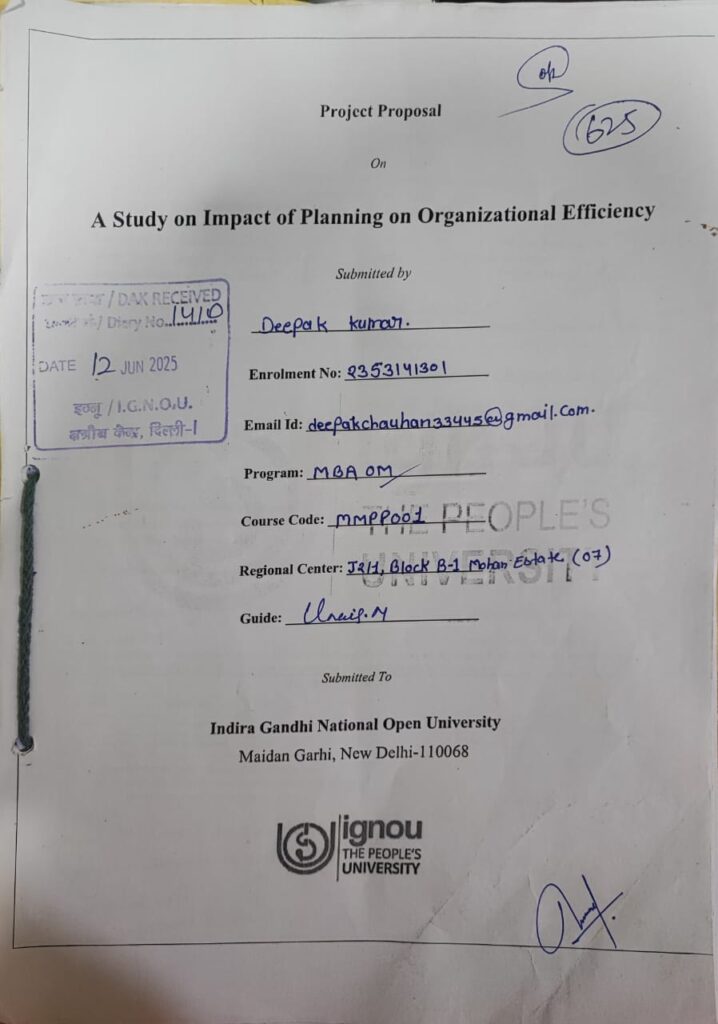Picture this: You’re deep into your IGNOU course, and the project deadline looms like a storm cloud. It feels overwhelming, right? But here’s the good news—nailing your IGNOU Project can boost your grades and prove your skills. These projects matter a lot in programs like MCA or MBA, where they demand fresh ideas and tight structure. They test if you can apply what you’ve learned. This guide walks you through every step, from picking a topic to submitting on time. Follow along, and you’ll craft a project that stands out without the stress.
Understanding IGNOU Project Requirements
IGNOU sets clear rules for projects to keep things fair and academic. Knowing these upfront saves headaches later. Let’s break it down so you start strong.
Types of IGNOU Projects Across Courses
IGNOU projects vary by course, but they all build on your studies. In MCA, you might code a simple app as your project. BBA students often tackle business plans, while MBA folks dive into case studies. Check your course handbook on the IGNOU site for exact details. Pick the type that fits your goals—say, a market analysis if you’re in commerce. This choice shapes your whole work, so think about what excites you most.
To select wisely, review past samples from your regional center. They show real examples, like a tourism project for BA students. Action tip: List three options from your syllabus and match them to your strengths. This way, your IGNOU project feels personal and doable.
Key Guidelines and Submission Deadlines
IGNOU’s rules cover basics like font size and page limits. Use Times New Roman, 12-point, with 1.5 line spacing and 1-inch margins. Most projects run 80 to 100 pages, but check your course for tweaks. Deadlines pop up twice a year—June and December—so mark your calendar now. Visit ignou.ac.in to grab the latest templates and updates; they change yearly.
Pro tip: Download the project handbook right away. It lists word counts, like 10,000 for dissertations. If you miss a deadline, extensions are rare, so plan ahead. This keeps your IGNOU project submission smooth.
Essential Components of an IGNOU Project
Every project needs a title page, abstract, and bibliography to pass muster. The title page lists your name, course code, and guide’s details. Abstracts sum up your work in 200 words—keep it crisp. Then, chapters flow from intro to conclusion, with references at the end.
Align these with evaluation points: originality scores 30%, research 40%. Add declarations for authenticity. Actionable advice: Use the template to slot in each part. This setup boosts your chances for top marks on your IGNOU project.
Choosing and Refining Your Project Topic
Picking the right topic sets the tone for success. It’s like choosing the foundation for a house—get it wrong, and everything wobbles. Focus on ideas that tie to IGNOU standards, and you’ll refine them fast.
Brainstorming Relevant Topics
Start by scanning your IGNOU syllabus for hot areas. Jot down ideas from class notes or current events, like digital marketing for BBA. Mind mapping helps: Draw a central theme and branch out sub-ideas. Keep it feasible—aim for topics you can finish in three months.
Review old projects at your library for sparks. For MCA, think app security; for MBA, supply chain tweaks. Tip: Set a 30-minute timer to list 10 topics. Narrow to five that spark your interest. This makes brainstorming fun and productive for your IGNOU project.
Evaluating Topic Viability and Originality
Test your ideas for freshness and fit. Search Google Scholar or IGNOU’s eGyankosh for similar works—avoid repeats. Check if data is easy to get; rural topics might need travel, so pick wisely.
Consult your supervisor early—they spot flaws quick. Ask: Does this add value? Revise based on feedback, like shifting from broad “e-commerce” to “e-commerce in small towns.” Steps: 1) Outline key questions. 2) Hunt sources. 3) Rate feasibility on a 1-10 scale. Strong topics lead to original IGNOU projects that impress.
Getting Approval for Your Topic
Synopsis submission is your next hurdle—IGNOU requires it before full work. Write a one-page proposal: state problem, goals, and methods. Submit via your regional center’s portal.
Follow up in a week if no reply. Tips: Keep it under 500 words, use simple language. Include why it matters for your course. Once approved, you’re green-lit. This step locks in your IGNOU project topic without surprises.
Conducting Research for Your IGNOU Project
Research forms the heart of your project. It’s where ideas turn solid. Stick to trusted sources, and you’ll build proof that shines.
Gathering Primary and Secondary Data
Primary data comes from you—like surveys or interviews. For a BBA project, poll local shops on sales trends. Secondary pulls from books, journals, or reports. Hit IGNOU’s eGyankosh for free e-books; Google Scholar spots articles fast.
Mix both for depth: 60% secondary, 40% primary works well. Tip: Use free tools like SurveyMonkey for quick polls. Track sources in a notebook from day one. This gathers strong data for your IGNOU project research.
Organizing and Analyzing Data
Sort your info with tools like Excel—create tabs for raw data and summaries. Group findings by theme, say customer feedback categories. Basic analysis: Spot patterns with averages or charts.
Ensure it ties to your topic; ditch irrelevant bits. Steps: 1) Input data neatly. 2) Run simple stats. 3) Cross-check for errors. Reliable data makes your IGNOU project analysis credible and easy to follow.
Avoiding Plagiarism and Ethical Issues
IGNOU cracks down on copying—zero tolerance means failing grades. Cite every source right, using APA style for social sciences or MLA for others. Tools like Grammarly’s checker flag issues early.
Get consent for interviews to stay ethical. Tip: Paraphrase in your words, then quote sparingly. Run a final Turnitin scan before submit. Clean work keeps your IGNOU project honest and high-scoring.
Structuring and Writing Your IGNOU Project Report
Now, shape your research into words. Think of it as building a story—clear and engaging. Follow this blueprint for a pro report.
Outlining the Report Structure
Start with chapters: Intro sets the scene, methodology explains how, findings share results, conclusion wraps up. Add appendices for extras like full surveys.
Template: Chapter 1 (5 pages), Chapter 2 (20 pages lit review), and so on. This outline guides your flow. Adjust for your course, but keep it logical. A solid structure streamlines your IGNOU project writing.
Writing Key Sections Effectively
Craft the lit review by summing past studies—link them to your gap. Methodology details steps, like “I surveyed 50 people via online forms.” Results use charts; explain what they mean without fluff.
Keep language simple: Short sentences pack punch. Add visuals— a pie chart beats plain text. Tip: Write one section daily to build momentum. This makes your IGNOU project report sharp and reader-friendly.
Editing and Proofreading for Quality
Revise alone first: Read aloud to catch awkward spots. Then, swap with a peer for fresh eyes. Tools like Hemingway App simplify sentences.
Aim for 80-100 pages, focused not fluffy. Check against guidelines—fix margins or fonts. Steps: 1) Fix big issues. 2) Hunt grammar slips. 3) Final read. Polished work elevates your IGNOU project.
Finalizing and Submitting Your IGNOU Project
The finish line nears. Polish details and submit right to avoid delays. This seals your hard work.
Formatting and Binding the Project
Match IGNOU specs: Hard cover in blue or black, spiral inside if allowed. Print double-sided on A4 paper, 80 GSM quality.
Include signed declarations and certificates. Tip: Use a local printer familiar with academic binds. Number pages correctly. Proper format makes your IGNOU project look official.
Submission Process and Follow-Up
Submit online via IGNOU’s portal or hand in at your center—check your course rules. Deadlines: June 30 for July session, December 31 for January.
Checklist: Cover all components? Fee paid? Track status online. Follow up for viva dates. Smooth submission gets your IGNOU project evaluated fast.
Preparing for Evaluation and Viva Voce
Review your work; know strengths cold. Practice answers: “Why this topic?” or “What limits did you face?” Use IGNOU’s rubric—clarity scores high.
Mock vivas with friends build confidence. Tip: Prepare slides if needed. Strong prep turns nerves into wins for your IGNOU project defense.
Conclusion
Making project not easy as making IGNOU Handwritten Assignment. You learned to grasp requirements, research deeply, write clearly, and submit smart. Key takeaways: Jump in early, stick to guidelines, and grab supervisor input often. These steps turn challenges into triumphs. Apply them now—your academic success awaits. Start your project today and watch your grades soar.



